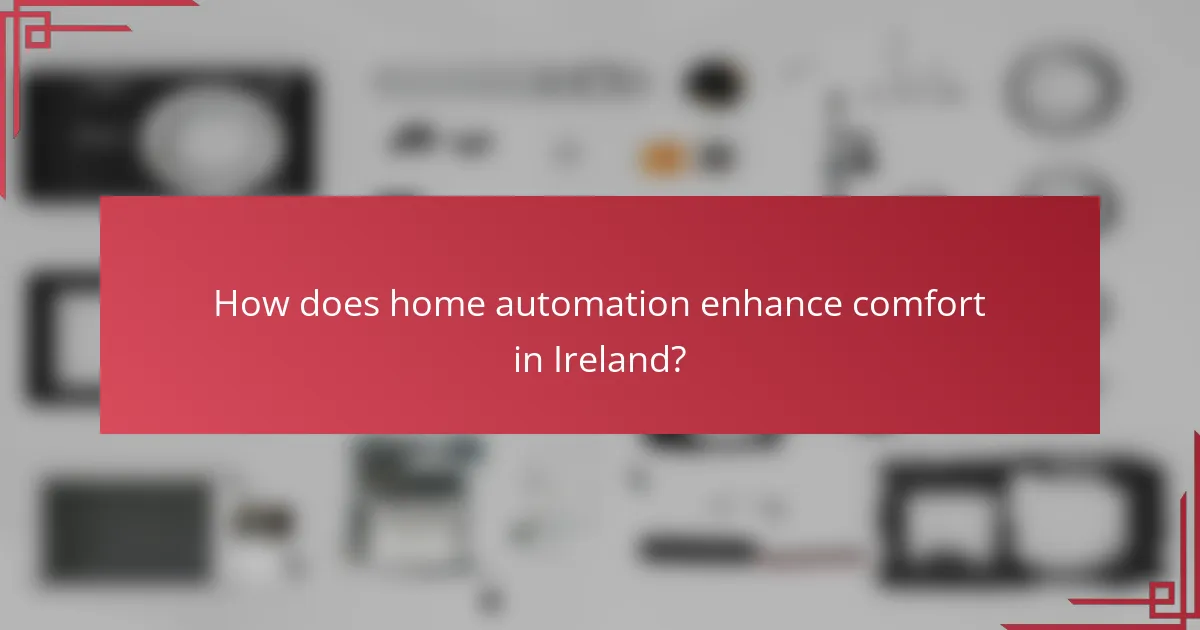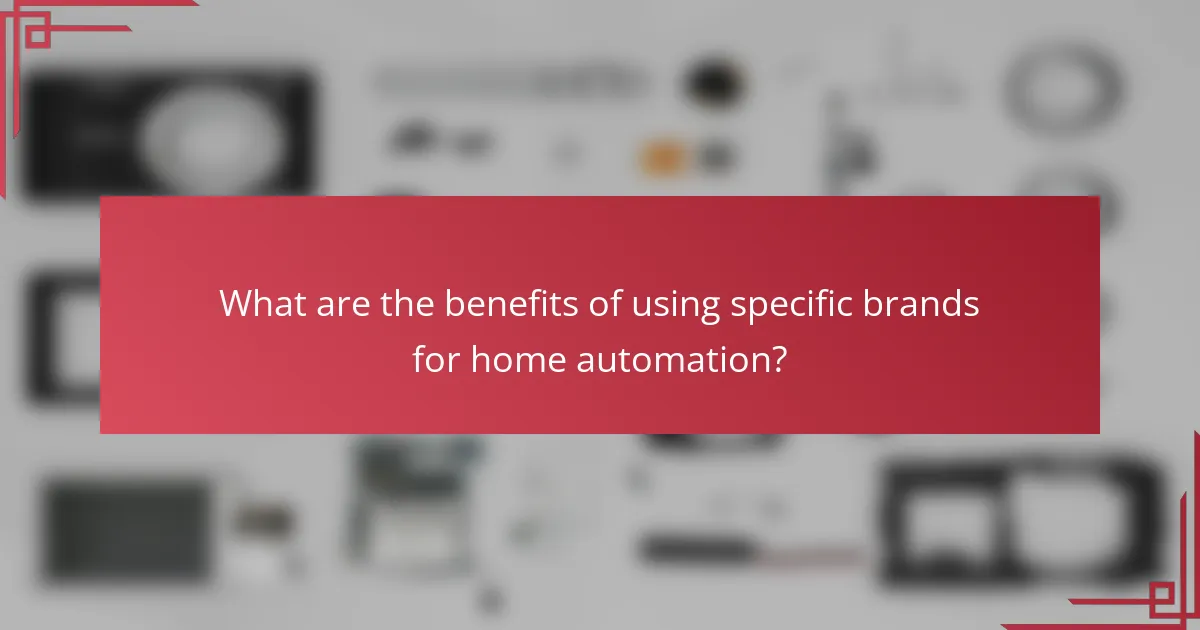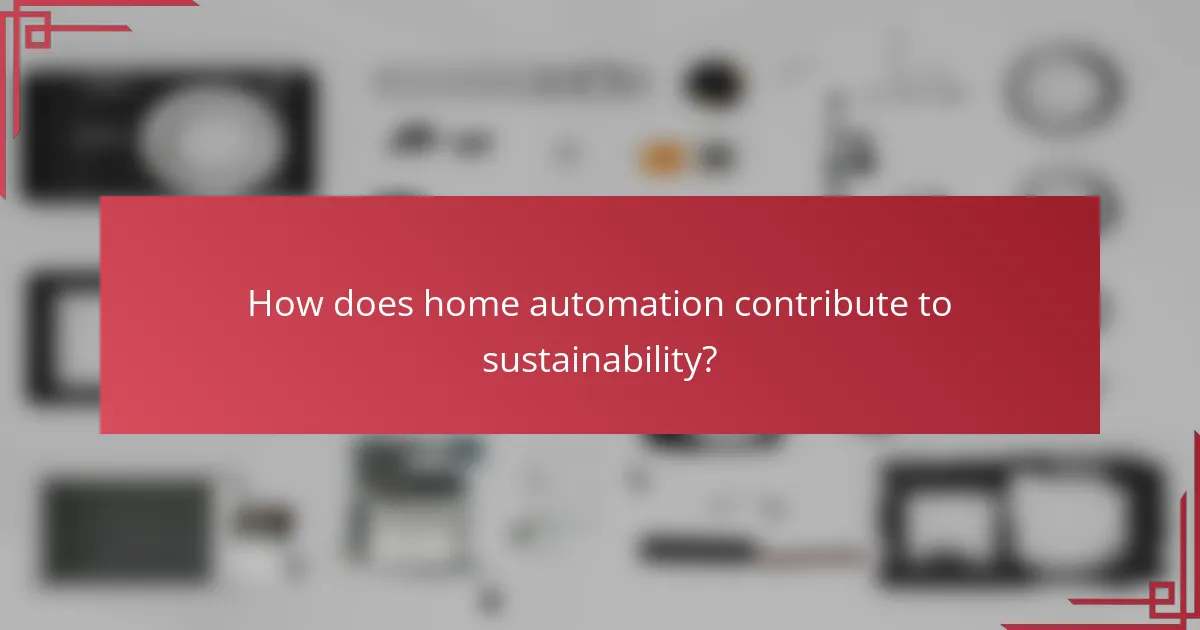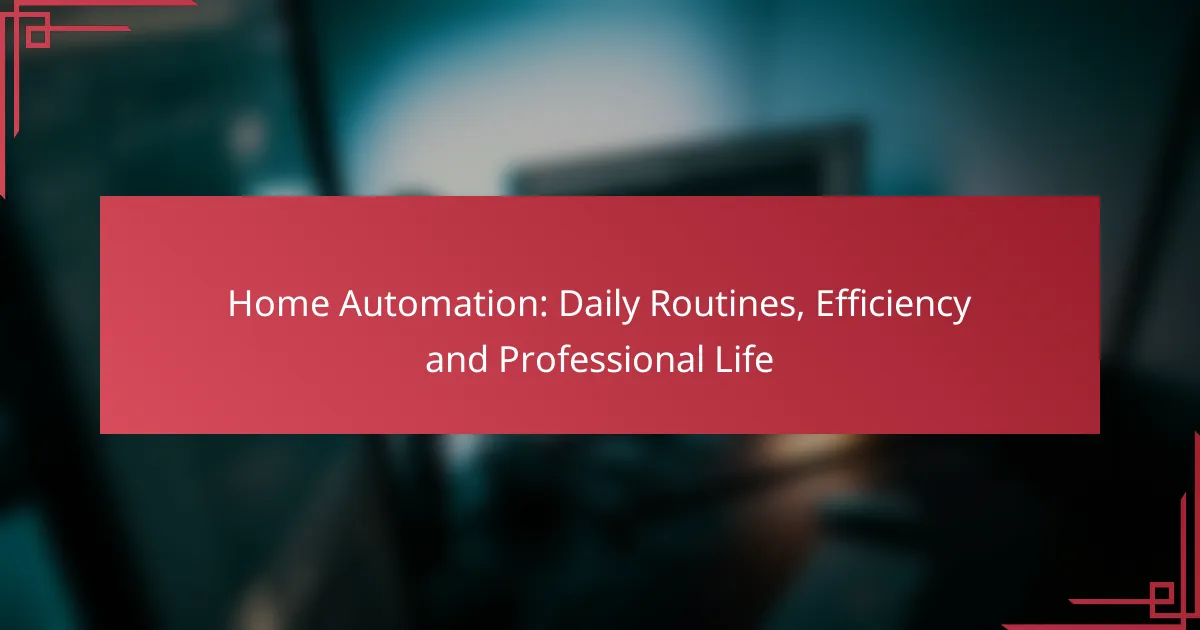Home automation transforms living spaces into personalized sanctuaries of comfort and convenience. By integrating smart technologies, residents can effortlessly manage their environment, tailoring settings for temperature, lighting, and security to suit their individual lifestyles. This adaptability not only enhances daily living but also promotes energy efficiency and peace of mind.

How does home automation enhance comfort in Ireland?
Home automation significantly enhances comfort in Ireland by allowing residents to control their living environment with ease and efficiency. Smart technologies enable tailored settings for temperature, lighting, and security, creating a more enjoyable and convenient lifestyle.
Smart thermostats for temperature control
Smart thermostats are essential for maintaining optimal temperature levels in Irish homes. These devices learn your heating preferences and adjust automatically, ensuring comfort while minimizing energy consumption. Many models can be controlled remotely via smartphone apps, allowing you to make adjustments even when you’re away.
Consider investing in a thermostat compatible with local heating systems, such as gas or oil boilers, to maximize efficiency. Look for features like geofencing, which adjusts the temperature based on your location, and energy usage reports to help you monitor costs.
Automated lighting systems for ambiance
Automated lighting systems enhance the ambiance of your home by allowing you to control brightness and color temperature with ease. These systems can be programmed to adjust according to the time of day or your activities, creating a welcoming atmosphere for different occasions.
When selecting a lighting system, consider options that integrate with existing smart home devices. Look for features like dimming capabilities and scene settings, which can transform your space for movie nights or dinner parties. Additionally, energy-efficient LED bulbs can help reduce electricity bills while providing the desired lighting effects.
Remote access for convenience
Remote access is a key feature of home automation that enhances convenience. With the ability to control various systems from your smartphone or tablet, you can manage heating, lighting, and security from anywhere, ensuring your home is always comfortable and secure.
To make the most of remote access, choose devices that offer user-friendly apps and reliable connectivity. Be cautious about security; ensure your network is protected and consider using two-factor authentication for added safety. This way, you can enjoy the benefits of home automation without compromising your privacy.

What are the key features of adaptable home automation systems?
Adaptable home automation systems are designed to enhance comfort and convenience by adjusting to individual preferences and lifestyles. Key features include integration with smart devices, customizable settings, and the ability to learn user habits over time.
Integration with voice assistants like Amazon Alexa
Integration with voice assistants such as Amazon Alexa allows users to control their home automation systems through simple voice commands. This feature enhances convenience, enabling hands-free operation of lights, thermostats, and security systems.
To maximize this integration, ensure that all devices are compatible with Alexa. Regularly update the software of your devices to maintain seamless communication and functionality.
Customizable settings for individual preferences
Customizable settings enable users to tailor their home automation systems to fit their specific needs and preferences. This can include adjusting lighting levels, temperature settings, and security alerts based on personal routines.
Consider creating different profiles for family members to accommodate varying preferences. Regularly review and adjust these settings as lifestyles change to ensure ongoing comfort and efficiency.

How can home automation improve lifestyle in urban areas?
Home automation enhances lifestyle in urban areas by providing convenience, efficiency, and security. Smart technologies allow residents to control their environment easily, leading to improved comfort and reduced energy consumption.
Energy efficiency through smart devices
Smart devices contribute significantly to energy efficiency by optimizing usage patterns. For instance, smart thermostats can learn your schedule and adjust heating or cooling automatically, potentially reducing energy bills by 10-20%.
Additionally, smart lighting systems can be programmed to turn off when rooms are unoccupied or adjust based on natural light levels. This not only saves energy but also extends the lifespan of bulbs, making it a cost-effective solution.
Enhanced security with smart cameras
Smart cameras enhance security in urban homes by providing real-time monitoring and alerts. These devices can be accessed remotely via smartphones, allowing homeowners to check on their property from anywhere at any time.
Many smart cameras also feature motion detection and night vision capabilities, which can deter potential intruders. It’s advisable to choose models that offer cloud storage for recorded footage, ensuring that important evidence is preserved in case of an incident.

What factors should you consider when choosing home automation solutions?
When selecting home automation solutions, consider compatibility with your existing devices and the scalability for future upgrades. These factors ensure that your system integrates smoothly and can evolve with your needs over time.
Compatibility with existing devices
Compatibility is crucial when choosing home automation solutions, as it determines how well new devices will work with your current setup. Check if the automation system supports popular protocols like Zigbee, Z-Wave, or Wi-Fi, which many smart devices use.
For example, if you already have smart bulbs or thermostats, ensure the new automation hub can connect with them. A lack of compatibility can lead to frustration and additional costs for replacements or adapters.
Scalability for future upgrades
Scalability allows your home automation system to grow with your needs. Choose a solution that can easily integrate new devices or features without requiring a complete overhaul of your existing setup.
Look for systems that offer modular components or cloud-based services, which can be updated remotely. This way, you can add new functionalities or devices over time, ensuring your home remains modern and efficient.

What are the costs associated with home automation in Ireland?
The costs of home automation in Ireland can vary significantly based on the complexity of the systems and the specific products chosen. Generally, homeowners should anticipate initial setup costs along with ongoing maintenance and subscription fees to keep the systems functional and updated.
Initial setup costs for smart systems
Initial setup costs for smart home systems in Ireland typically range from a few hundred to several thousand euros, depending on the technology and scale of the installation. Basic systems, such as smart lighting or thermostats, may start around €200, while comprehensive setups including security systems, smart appliances, and home hubs can exceed €5,000.
When planning your budget, consider the cost of professional installation versus DIY options. Professional services may add €100 to €500 to your total costs, but they can ensure proper integration and functionality of the devices.
Ongoing maintenance and subscription fees
Ongoing maintenance and subscription fees for home automation systems can add to your monthly expenses. Many smart devices require subscriptions for premium features, cloud storage, or advanced security services, typically costing between €5 and €30 per month.
Additionally, consider potential costs for software updates and technical support. While some manufacturers offer free updates, others may charge for extended warranties or service plans, which can range from €50 to €150 annually. Regularly reviewing these costs can help you manage your overall budget effectively.

What are the benefits of using specific brands for home automation?
Using specific brands for home automation can enhance reliability, compatibility, and user experience. Established brands often provide better customer support, regular updates, and a wider range of compatible devices, making it easier to create a cohesive smart home ecosystem.
Philips Hue for smart lighting
Philips Hue offers a versatile range of smart lighting solutions that can be easily integrated into any home. With options for color-changing bulbs, dimmable lights, and various fixtures, users can customize their lighting to suit different moods and activities.
Consider the Zigbee protocol used by Philips Hue, which allows for seamless communication between devices. This ensures that your lighting can be controlled via smartphone apps or voice assistants, providing convenience and adaptability.
When setting up Philips Hue, ensure your Wi-Fi network is stable and consider using a Hue Bridge for enhanced functionality. This device allows for remote access and the ability to control lights even when you are away from home.
Nest for smart thermostats
Nest smart thermostats are designed to optimize home heating and cooling, leading to increased energy efficiency. These devices learn your schedule and preferences, adjusting temperatures automatically to save energy when you are not home.
Installation is typically straightforward, but ensure compatibility with your existing HVAC system before purchasing. The Nest app allows for remote temperature control, making it easy to adjust settings from anywhere.
To maximize savings, take advantage of the Nest’s energy-saving features, such as Eco Mode, which can significantly reduce energy consumption. Regularly check for software updates to ensure your thermostat operates at peak efficiency.

How does home automation contribute to sustainability?
Home automation enhances sustainability by optimizing energy use and reducing waste. Smart systems can adjust lighting, heating, and cooling based on occupancy and preferences, leading to significant energy savings.
Reduced energy consumption
Home automation systems can significantly lower energy consumption by intelligently managing appliances and systems. For instance, smart thermostats can learn your schedule and adjust heating or cooling when you’re away, potentially reducing energy use by 10-20%.
Additionally, automated lighting systems can turn off lights in unoccupied rooms or adjust brightness based on natural light levels. This not only saves electricity but also extends the lifespan of bulbs, reducing waste.
To maximize energy savings, consider integrating devices that communicate with each other. For example, linking smart blinds with a thermostat can optimize indoor temperatures by blocking heat during the day or allowing sunlight in when needed.



